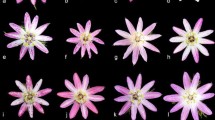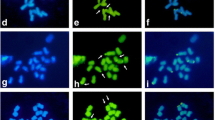Abstract
Supernumerary (B) chromosomes and small aberrant chromosomes were detected in Lilium hybrids and characterized through genomic in situ hybridization (GISH) and florescence in situ hybridization (FISH). Two small, supernumerary or B chromosomes were detected as extra chromosomes in a tetraploid plant derived from chromosome doubling of a hybrid (2n = 2x = 24) between a cultivar of the Longiflorum (L) and the Trumpet (T) group. When this tetraploid LLTT hybrid was crossed with a triploid LLO hybrid (O = Oriental), the B chromosome was transmitted to 73.4 % of the progenies. Based on GISH and FISH characterization, it was shown that the B chromosome consisted of two identical arms, with 5S rDNA hybridizing to the majority of it, which were flanked by normal telomeres, suggesting that this is an isochromosome. In another population, which is a backcross progeny between a F1 hybrid of Longiflorum × Asiatic (LA) and its Asiatic parent, the former produced functional 2n gametes which resulted in a triploid LAA progeny (2n = 3x = 36), in which three exceptional plants possessed 35 normal chromosomes and a small aberrant chromosome instead of the expected normal number of 36. In all three cases, the small aberrant chromosomes were isochromosomes which had obviously originated during the first backcross generation. These three chromosomes showed normal telomeres and mitosis. In addition, one of the new generated chromosomes possessed two 45S rDNA sites in the proximal positions. These new arisen isochromosomes were proposed to originate from centric breakage and fusion of two short arms of the missing chromosome in three genotypes, respectively, based on the comparison of arm lengths as well as rDNA loci. Their relevance to the origin of Bs is discussed.



Similar content being viewed by others
Abbreviations
- GISH:
-
Genomic in situ hybridization
- FISH:
-
Florescence in situ hybridization
- Bs:
-
B chromosomes
- rDNA:
-
Ribosomal DNA
References
Barba-Gonzalez R, Ramanna MS, Visser RGF, Van Tuyl JM (2005) Intergenomic recombination in F1 lily hybrids (Lilium) and its significance for genetic variation in the BC1 progenies as revealed by GISH and FISH. Genome 48(5):884–894
Barthes L, Ricroch A (2001) Interspecific chromosomal rearrangements in monosomic addition lines of Allium. Genome 44(5):929–935
Bennett M, Smith J (1976) Nuclear DNA amounts in angiosperms. Philos Trans Roy Soc London Ser B 274(933):227
Beukeboom LW (1994) Bewildering Bs: an impression of the 1st B-chromosome conference. Heredity 73:328–336
Brandram S (1967) Cytogenetic studies of the Genus Lilium. M.Sc. thesis. The University of London
Camacho JPM, Sharbel TF, Beukeboom LW (2000) B-chromosome evolution. Philos Trans Roy Soc London Ser B 355(1394):163
Cox AV, Bennett ST, Parokonny AS, Kenton A, Callimassia MA, Bennett MD (1993) Comparison of plant telomere locations using a PCR-generated synthetic probe. Ann Bot 72(3):239–247
Dhar PK, Kryscio A, Streffer C (2000) Application of FISH-MN technique to probe micronuclei formation in normal, transformed and malignant cells using alpha satellite pan centromeric DNA. Curr Sci 78(10):1247–1249
Dhar MK, Friebe B, Koul AK, Gill BS (2002) Origin of an apparent B chromosome by mutation, chromosome fragmentation and specific DNA sequence amplification. Chromosoma 111(5):332–340
Donald TM, Leach CR, Clough A, Timmis JN (1995) Ribosomal RNA genes and the B chromosome of Brachycome dichromosomatica. Heredity 74(5):556–561
Flavell R, Rimpau J (1975) Ribosomal RNA genes and supernumerary B-chromosomes of rye. Heredity 35:127–131
Friebe B (1989) Nucleolar activity of B-chromosomes in Allium cernuum (Alliaceae). Plant Syst Evol 163(1):87–92
Friebe B, Jiang J, Gill B (1995) Detection of 5S rDNA and other repeated DNA on supernumerary B chromosomes of Triticum species (Poaceae). Plant Syst Evol 196(3):131–139
Gerlach W, Bedbrook J (1979) Cloning and characterization of ribosomal RNA genes from wheat and barley. Nucleic Acids Res 7(7):1869–1885
Ijdo J, Wells R, Baldini A, Reeders S (1991) Improved telomere detection using a telomere repeat probe (TTAGGG)n generated by PCR. Nucleic Acids Res 19(17):4780
Jones RN (1995) B chromosomes in plants. New Phytol 131(4):411–434
Jones N, Houben A (2003) B chromosomes in plants: escapees from the A chromosome genome? Trends Plant Sci 8(9):417–423
Jones RN, Rees H (1982) B chromosomes. Academic Press
Jones RN, González-Sánchez M, González-García M, Vega J, Puertas M (2008a) Chromosomes with a life of their own. Cytogenet Genome Res 120(3–4):265–280
Jones RN, Viegas W, Houben A (2008b) A century of B chromosomes in plants: so what? Ann Bot 101(6):767–775
Kaszas I, Kato A, Birchler JA (2002) Cytological and molecular analysis of centromere misdivision in maize. Genome 45(4):759–768
Kayano H (1957) Cytogenetic studies in Lilium callosum. Proc Jpn Acad 33(9):553–558
Khan N, Barba-Gonzalez R, Ramanna MS, Visser RGF, Van Tuyl JM (2009) Construction of chromosomal recombination maps of three genomes of lilies (Lilium) based on GISH analysis. Genome 52(3):238–251
Kimura M, Kayano H (1961) The maintenance of supernumerary chromosomes in wild populations of Lilium callosum by preferential segregation. Genetics 46(12):1699–1712
Lawrence G, Appels R (1986) Mapping the nucleolus organizer region, seed protein loci and isozyme loci on chromosome 1R in rye. Theor Appl Genet 71(5):742–749
Levin DA, Palestis BG, Jones RN, Trivers R (2005) Phyletic hot spots for B chromosomes in angiosperms. Evolution 59(5):962–969
Lim KB, Wennekes J, De Jong JH, Jacobsen E, Van Tuyl JM (2001) Karyotype analysis of Lilium longiflorum and Lilium rubellum by chromosome banding and fluorescence in situ hybridisation. Genome 44(5):911–918
Lukaszewski AJ (2010) Behavior of centromeres in univalents and centric misdivision in Wheat. Cytogenet Genome Res 129(1–3):97–109
Maluszynska J, Schweizer D (1989) Ribosomal RNA genes in B chromosomes of Crepis capillaris detected by non-radioactive in situ hybridization. Heredity 62(1):59–65
Moens PB (1965) The transmission of a heterochromatic isochromosome in Lycopersicon esculentum. Can J Genet Cytol 7(2):296–303
Murray M, Thompson W (1980) Rapid isolation of high molecular weight plant DNA. Nucleic Acids Res 8(19):4321
Quiros CF (1976) Selection for increased numbers of extra heterochromatic chromosomes in the tomato. Genetics 84(1):43–50
Ramanna MS, Hille J, Zabel P (1985) Chromosome breakage-fusion-bridge-cycle and phenotypic instability in isochromosome lines of tomato. Theor Appl Genet 71(2):145–152
Reeves A, Tear J (2000) MicroMeasure for Windows, version 3.3. www.colostate.edu/Depts/Biology/MicroMeasure
Ross KJ, Fransz P, Jones GH (1996) A light microscopic atlas of meiosis in Arabidopsis thaliana. Chromosome Res 4(7):507–516
Stewart RN (1947) The morphology of somatic chromosomes in Lilium. Am J Bot 34:9–26
Trivers R, Burt A, Palestis BG (2004) B chromosomes and genome size in flowering plants. Genome 47(1):1–8
Zhou S, Ramanna MS, Visser RGF, Van Tuyl JM (2008) Analysis of the meiosis in the F1 hybrids of Longiflorum × Asiatic (LA) of lilies (Lilium) using genomic in situ hybridization. J Genet Genomics 35(11):687–695
Zonneveld BJM, Leitch IJ, Bennett MD (2005) First nuclear DNA amounts in more than 300 angiosperms. Ann Bot 96(2):229–244
Author information
Authors and Affiliations
Corresponding author
Rights and permissions
About this article
Cite this article
Xie, S., Marasek-Ciolakowska, A., Ramanna, M.S. et al. Characterization of B chromosomes in Lilium hybrids through GISH and FISH. Plant Syst Evol 300, 1771–1777 (2014). https://doi.org/10.1007/s00606-014-1004-1
Received:
Accepted:
Published:
Issue Date:
DOI: https://doi.org/10.1007/s00606-014-1004-1




